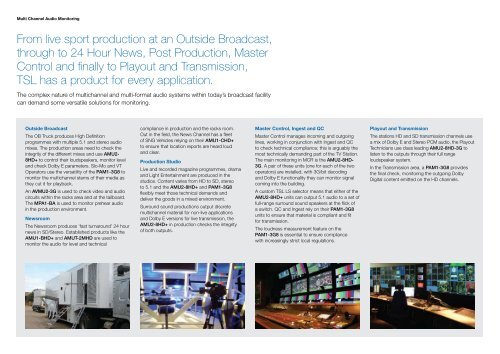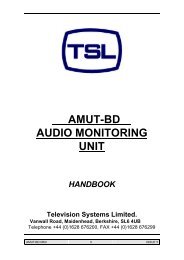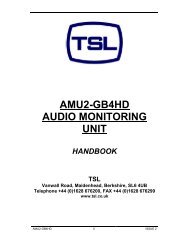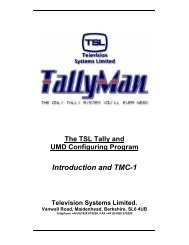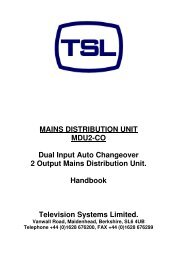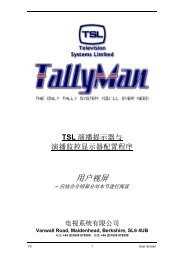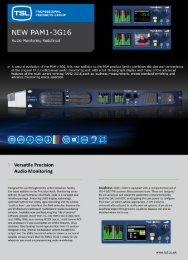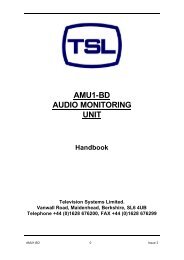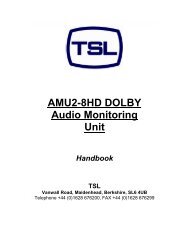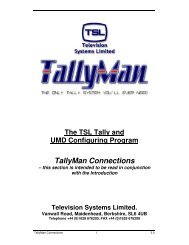Audio Monitoring Units (AMU) - TSL
Audio Monitoring Units (AMU) - TSL
Audio Monitoring Units (AMU) - TSL
Create successful ePaper yourself
Turn your PDF publications into a flip-book with our unique Google optimized e-Paper software.
Multi Channel <strong>Audio</strong> <strong>Monitoring</strong><br />
From live sport production at an Outside Broadcast,<br />
through to 24 Hour News, Post Production, Master<br />
Control and finally to Playout and Transmission,<br />
<strong>TSL</strong> has a product for every application.<br />
The complex nature of multichannel and multi-format audio systems within today’s broadcast facility<br />
can demand some versatile solutions for monitoring.<br />
Outside Broadcast<br />
The OB Truck produces High Definition<br />
programmes with multiple 5.1 and stereo audio<br />
mixes. The production areas need to check the<br />
integrity of the different mixes and use <strong>AMU</strong>2-<br />
8HD+ to control their loudspeakers, monitor level<br />
and check Dolby E parameters. Slo-Mo and VT<br />
Operators use the versatility of the PAM1-3G8 to<br />
monitor the multichannel stems of their media as<br />
they cut it for playback.<br />
An AVMU2-3G is used to check video and audio<br />
circuits within the racks area and at the tailboard.<br />
The MPA1-BA is used to monitor prehear audio<br />
in the production environment.<br />
Newsroom<br />
The Newsroom produces ‘fast turnaround’ 24 hour<br />
news in SD/Stereo. Established products like the<br />
<strong>AMU</strong>1-BHD+ and <strong>AMU</strong>T-2MHD are used to<br />
monitor the audio for level and technical<br />
compliance in production and the racks room.<br />
Out in the field, the News Channel has a fleet<br />
of SNG Vehicles relying on their <strong>AMU</strong>1-CHD+<br />
to ensure that location reports are heard loud<br />
and clear.<br />
Production Studio<br />
Live and recorded magazine programmes, drama<br />
and Light Entertainment are produced in the<br />
studios. Content varies from HD to SD, stereo<br />
to 5.1 and the <strong>AMU</strong>2-8HD+ and PAM1-3G8<br />
flexibly meet those technical demands and<br />
deliver the goods in a mixed environment.<br />
Surround sound productions output discrete<br />
multichannel material for non-live applications<br />
and Dolby E versions for live transmission, the<br />
<strong>AMU</strong>2-8HD+ in production checks the integrity<br />
of both outputs.<br />
Master Control, Ingest and QC<br />
Master Control manages incoming and outgoing<br />
lines, working in conjunction with Ingest and QC<br />
to check technical compliance; this is arguably the<br />
most technically demanding part of the TV Station.<br />
The main monitoring in MCR is the <strong>AMU</strong>2-8HD-<br />
3G. A pair of these units (one for each of the two<br />
operators) are installed, with 3G/bit decoding<br />
and Dolby E functionality they can monitor signal<br />
coming into the building.<br />
A custom <strong>TSL</strong> LS selector means that either of the<br />
<strong>AMU</strong>2-8HD+ units can output 5.1 audio to a set of<br />
full-range surround sound speakers at the flick of<br />
a switch. QC and Ingest rely on their PAM1-3G8<br />
units to ensure that material is compliant and fit<br />
for transmission.<br />
The loudness measurement feature on the<br />
PAM1-3G8 is essential to ensure compliance<br />
with increasingly strict local regulations.<br />
Playout and Transmission<br />
The stations HD and SD transmission channels use<br />
a mix of Dolby E and Stereo PCM audio, the Playout<br />
Technicians use class leading <strong>AMU</strong>2-8HD-3G to<br />
listen to the outputs through their full range<br />
loudspeaker system.<br />
In the Transmission area, a PAM1-3G8 provides<br />
the final check, monitoring the outgoing Dolby<br />
Digital content emitted on the HD channels.


